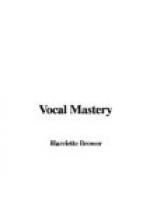“You can well believe it is far more difficult to sing a recital program than to do an operatic role. In the recital you are absolutely alone, and entirely responsible for your effect on the audience. You must be able to express every variety of emotion and feeling, must make them realize the difference between sorrow and happiness, revenge or disdain; in short, make them, for the moment, experience these things. The artist who can best vivify these varying emotions must have temperament. On the piano, you may hear players who express sentiment, feeling, fine discrimination in tone color and shading; but comparatively few possess real temperament. There is great difference between that quality and sentiment. The one can be learned, to a certain extent; but temperament is one’s very life and soul, and is bound to sweep everything before it. Of this one thing I am very sure; the singer cannot express all these emotions without feeling them to the full during performance. I always feel every phrase I sing—live it. That is why, after a long and exhausting program, I am perfectly limp and spent. For I have given all that was in me. Friends of Sara Bernhardt say that after a performance, they would find her stretched prone on a couch in her dressing room, scarcely able to move or speak. The strain of a public appearance, when one gives one’s heart’s blood, is beyond words”; and Madame’s upturned face and expressive gesture denoted how keenly alive she was to this experience.
After a little pause, I said: “Let us come down to earth, while you tell me just how you study. No doubt you do some daily technical practice.”
MASSAGE THE VOICE
“Oh, yes, technic is most important; one can do nothing without it. When I begin to study in the morning, I give the voice what I call a massage. One’s voice cannot be driven, it must be coaxed, enticed. This massage consists of humming exercises, with closed lips. Humming is the sunshine of the voice.” The singer illustrated the idea with a short musical figure, consisting of three consecutive tones of the diatonic scale, ascending and descending several times; on each repetition the phrase began on the next higher note of the scale. “You see,” she continued, “this little exercise brings the tone fully forward. As you feel the vibration, it should be directly between the eyes.
“Now, after you have coaxed the voice forward in this way, and then opened your lips to sing a full tone, this tone should, indeed must, be right in the same place where the humming tones were,—it cannot be anywhere else.” Madame illustrated again, first humming on one tone, then letting it out with full resonance, using the vowel Ah, which melted into O, and later changed into U, as the tone died away. “This vibration in the voice should not be confounded with a tremolo, which is, of course, very undesirable. A voice without vibrato, would be cold and dead, expressionless. There must be this pulsing quality in the tone, which carries waves of feeling on it.




